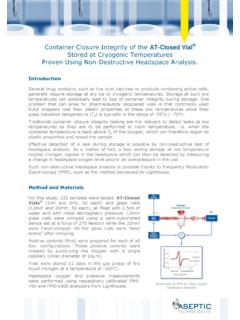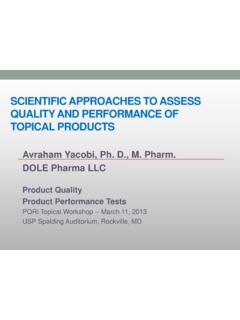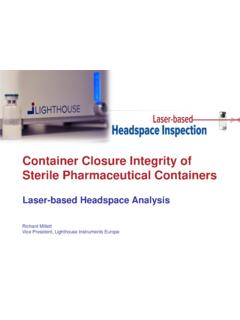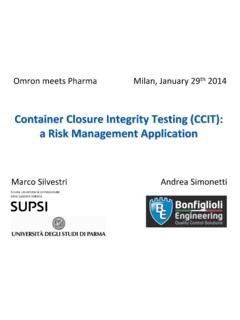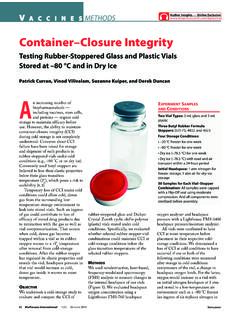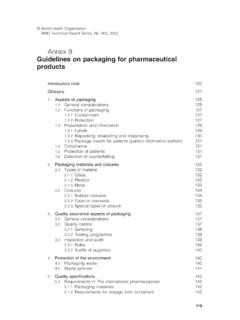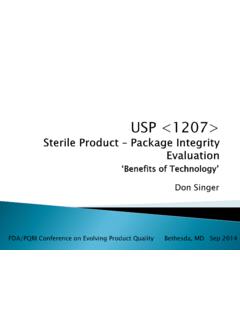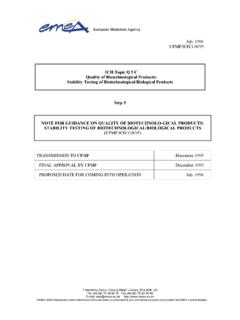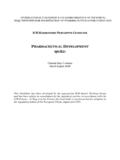Transcription of SCHOTT pharma services
1 SCHOTT pharma servicesSCHOTT pharma services Specialized analytics for pharmaceutical packagingSCHOTT pharma services specializes in the following areas:Chemical Durability Predictive and real-time delamination studies Par ticle analysis Glass surface testing (wetting and adsorption issues)Mechanical Stability Fractography and breakage analysis container strength testing Training course for fractography and strengthE&L + System Performance Extractables & leachables Elemental impurities Packaging components compliances Pharmacopeia testingMore than 40 Years Experience in testing of Pharmaceutical PackagingTesting according to current EP, USP, and JP regulatory guidelines and ICH are DIN EN ISO/IEC 17025 accredited (DAkkS and ILAC) and FDA level of quality management confirmed by regular customer quality is a leading international technology group in the areas of specialty glass and glass-ceramics. With more than 130 years of outstanding development, materials and technology expertise we offer a broad portfolio of high-quality products and intelligent solutions that contribute to our customers success.
2 SCHOTT pharma services provides analytical laboratory services for pharmaceutical packaging. Our unique combination of specialized analytics and expertise in materials, products, and processes enables us to support pharmaceutical companies in finding solutions for the most challenging packaging AGHattenbergstra e 1055122 MainzGermanyPhone: +49 (0)6131/66-7339 Fax: +49 ENGLISH-ROW 07/2019 ali/nino Printed in GermanyBreakage Analysis Fractography Broken samples and cracks tell stories and leave behind clues. By applying optical and scanning electron microscopy, the fracture origin and propagation of glass breakage can be determined. Clear evidence for the root cause can be drawn and the applied force leading to failure can be determined. The glass container integrity can be additionally assessed by dye penetration testing Strength testing allows the prediction of fracture probabilities of glass containers. Samples from different process steps (purpose: process mapping), different lots or different manufacturers can be compared and evaluated.
3 Burst pressure testing reveals the weakest spot of a container , while specific tests target critical areas like the flange or Course for Fractography and Strength Two day on-site course focusing on glass production, testing , glass properties, fracture mechanics and statistics, strength testing and Weibull distributions, fracture patterns, fracture surface markings, sample preparation, imaging techniques, and detailed hands-on Stability TestsBasis for weak point analyses of production lines or container designbarrel regionshoulder regionFracture surface of a cracked cartridge revealing macroscopic fracture patternsBurst strength distribution, statistical evaluation by hypothesis testing Visualizing the mechanisms associated with glass to glass contact eventsDetermination of fracture origin confirms additional damage occurred near flangePhotograph of a typical fracture origin caused by a contact with a blunt object5 mmcartridge shouldercartridge bodychippingchippingtwist hacklecrack systemsurface markfracture surfacefracture surfacevial heel outer surfacewake hackletwist hacklevicinity of fracture originfracture origincrackFracture surface of a broken syringe revealing microscopic fracture markingsDye penetration testing concerning glass container integritybefore processafter process100150200250300350400p (bar)flange regiony (mm)01020304050100150200250300350400burs t pressure p (bar)after processbefore process10quantity N102015055500 m1000 mSCHOTT AGHattenbergstra e 1055122 MainzGermanyPhone: +49 (0)6131/66-7339 Fax.
4 +49 ENGLISH-ROW 07/2019 ali/nino Printed in Germany18828 Signal (cps)Retention time (min)Class 1Cd, Pb, As, HgClass 2 ACo, V, NiClass 2 BTl, Au, Pd, Ir, Os, Rh, Ru, Se, Ag, PtClass 3Li, Sb, Ba, Mo, Cu, Sn, CrOtherAI, B, Ca, Fe, K, Mg, Mn, Na, W, ZnAdditionalSiElements Tested100 1000 mmE&L data for all drug contact materials such as polymer barrel and rubber componentsChromatogram of leachables testing with an antioxidant in different oxidation states oxidized derivativeBHTE lements to be tested on the basis of ICH / USP route-of-administration risk assessment using High Resolution ICP-MSDetermination of total and free silicone by Graphite Furnace Atomic Absorption Spectro-metry (GF-AAS)Taking secondary packaging materials into account concerning potential leachablesExtractables Studies Customer oriented extractables studies for determination of organic and inorganic substances extracted out of primary packaging materials that can potentially migrate into the drug product.
5 Study protocols are based on most recent guideline recommendations: USP <1663>, USP <1664>, EP, ISO 10993 and and Real Time Leachables Studies Determination of leachables and cross reaction products with validated methods after storage of drug product within a closed con- tainer under accelerated and real time test conditions. All analyses are performed with current state-of-the-art equipment. Guideline expertise ( ICH M7) for assessment of results. Support for toxicological assessment possible by collaboration Impurities, total silicone, and free silicone Determination of elemental impurities (USP <232>, ICH Q3D) using validated methods by High Resolution ICP-MS. Determination of extractable and leachable silicone by and Leachables E&L data for material characterization and for registration purposesTip CapLuer LockPlunger RodCover lidNestTy vek InlayTubPlungerBarrelFlangeIntensity (cps)Intensity (counts)Retention time (min)m/zIS40103 ENGLISH-ROW 07/2019 ali/nino Printed in GermanyGlass compositionSiliconization presence/absence and uniformity using colored water droplet testCharacterization of inner container surface by Time of Flight Secondary Ion Mass Spectro-me-try (ToF-SIMS) Fingerprint of rubber extract by GC-MSChemical structure of borosilicate glassGlass Composition Identification of chemical glass composition of primary packaging containers and manufacturer based on comprehensive database of published glass Determination of applied coatings/treatments such as silicone oil, barrier coating, hydrophobic coating, chemical strengthening.
6 Compliance tests for packaging components and rubber characterization Compliance test methods available for glass containers USP <660>, EP (alkalinity, hydrolytic resistance, arsenic, needle) and rubber components (physico- chemical tests and particles). Identification of rubber material and coating by combination of different analytical methods. System Performance TestsBased on long term expertise in glass, coatings, polymer and elastomer components compliance testing (EP, USP, JP, ISO and other industry standards) SCHOTT AGHattenbergstra e 1055122 MainzGermanyPhone: +49 (0)6131/66-7339 Fax: +49 buffer (pH )Sodium bicarbonate (pH )Phosphate buffer (pH )B (mg/L) (mg/L) (mg/L) particles by visual inspection1. Dissolution1. Dissolution Erosion2. Selective Dissolution2. Selective Dissolution Erosion and weak porous layer3. Dissolution and Reaction3. Dissolution and Reaction Erosion and compound layerColoration ring by stereo-microscopy1800 m200 nm K XInterference colorationContainer Inspection and Screening Glass delamination screening starts with visual inspection by eye and camera methods to detect flake-like particles.
7 After emptying the container , stereomicroscopy is used to look for changed regions of a container for further surface analysis to determine the worst samples out of a sample Delamination Confirmation SEM cross section analysis, in combination with ICP-OES/MS solution analysis, is used to deter- mine the extent of attack of glass surface and confirm the mechanism of drug container interaction. Drug container Interaction SIMS depth profiling, SEM cross section analysis, and ICP-OES/MS solution analysis is used to determine the mechanism: 1. Dissolution 2. Selective dissolution 3. Dissolution and reactionChemical Durability TestsGlass delamination in accordance with USP <1660>40103 ENGLISH-ROW 07/2019 ali/nino Printed in GermanySodiumOxygenBoronAluminiumSilicon Drug elementNo risk for flakes (maybe precipitations)Risk for silicate flakesRisk for compoundflakesDrug solutionGlass surfaceSCHOTT AGHattenbergstra e 1055122 MainzGermanyPhone: +49 (0)6131/66-7339 Fax: +49 Delamination Screening Specially developed delamination screening package in accordance with USP <1660> to assess the likelihood for delamination occurring during the shelf life of the product.
8 A combination of tests investigating the container surface, the surface near region and the solution, allowing a determination for the risk of glass delamination to Analysis (Inorganics) Inorganic particles, particularly flake-like particles, need to be isolated via filtration and analyzed for chemical composition by SEM- EDS, Raman/FTIR and morphology by SEM-EDS to identify and deter- mine root cause. Common sources of inorganic particles are manufacturing by- products, deposits from processing, particle from Analysis (Organics) Organic particles need to be assessed in the same manner. Common sources of organic particles that are of human nature (skin, hair), fibers (clean room cloth, filters), formulation precipitates or secondary packaging material (polymer boxes, shrink wrap).Chemical Durability TestsScreening packages to assess potential risks and future avoidance40103 ENGLISH-ROW 07/2019 ali/nino Printed in Germany200 nm40 m020406080100 Distance from surface (nm) m-20-20-100102050010001500200025003000-1 00X ( m)Y ( m)1020 Raman shift ()Intensity (arb.)
9 Units)Intensity (counts)Intensity (counts) of the container wall by Scanning Electron MicroscopyFlake-like particle (left) which is an Al-Phosphate rich material (right) Micrograph of cellulose particle for morphology and sizeCorresponding Raman spectrum of cellulose with 532 nm laser excitationAltered elemental composition of surface near layer with B and Na depletionEnergy (keV) SCHOTT AGHattenbergstra e 1055122 MainzGermanyPhone: +49 (0)6131/66-7339 Fax: +49 Durability Tests ToF-SIMS Secondary Ion Mass Spectrometry and Depth Profiling SEM Scanning Electron Microscopy LiMi Stereo Microscopy EDS Energy-dispersive X-Ray Spectroscopy F-AAS, GF-AAS, HG-AAS Atomic Absorption Spectrometry HR ICP-MS High Resolution Inductive Coupled Plasma-Mass Spectrometry ICP-OES, Spark-OES Atomic Emission Spectrometry ICP-MS, Laser Ablation ICP-MS FTIR- and Raman-Microscopy Wet Chemistry, Gravimetry, Titration Hydrolytic Resistance Tests Sample Preparation for Tests including Washing, Depyrogenation, Filling, and SealingMechanical Stability Tests Fractography, Crack Origin, Microscopic Fracture Patterns Stress-optical Measurements Statistical Analysis of Strength Data Fracture Toughness Crack Initiation Load, Elastic and Plastic Indentation Static Strength, Tension-compression (uniaxial) Bending, Bursting (hydrostatic) Dynamic Strength, Notch Test, DCDC (crack growth) Climate testing FEA Finite Element Analysis 1.
10 | Hladik, B., Buscke, F., Frost, R., Rothhaar, U. Comparative Leachable Study for Glass Vials to Demonstrate the Impact of Low Fill Volume, J. Pharm. Sci. Technol. 2019, | Rothhaar, U., Klause, M., Hladik, B. Comparative Delamination Study to Demonstrate the Impact of container Quality and Nature of Buffer System, J. Pharm. Sci. Technol. 2016, 70, pgs 560 | Haines, D., Maurer, F., Rothhaar, U. Why do Pharmaceutical Glass Containers Break: The Underestimated Power of Strength testing and Fractography, International Pharmaceutical Industry, 2016, Vol 8, Issue 1, pgs 88 | Soegding, T., Canton, D.; Haines, D., Rothhaar, U. How Sterilization of Primary Packaging Influences the Results of E&L Studies, Contract pharma , 2015, June, pgs 88 | Haines, D.; Scheumann, V., Rothhaar, U. Glass Flakes: Pre- testing Stops a Big Problem before it Even Starts, Contract pharma 2013, June, pgs 92 according to DIN EN ISO/IEC 17025:Recent Publications & WhitepapersE&L and System Performance Tests GC-MS Gas Chromatography Mass Spectrometry GC-FID Gas Chromatography Flame Ionisation Detection HS-GC Headspace Gas Chromatography TD-GC Thermal desorption Gas Chromatography LC-Q-Tof and LC-MS-IT-TOF Liquid Chromatography high resolution Mass Spectrometry LC-DAD Liquid chromatography with UV/VIS detection IC Ion Chromatography ICP-OES Inductive Coupled Plasma Optical Emission Spectrometry ICP-MS Inductive Coupled Plasma Mass Spectrometry HR ICP-MS High Resolution Inductive Coupled Plasma Mass Spectrometry F-AAS, GF-AAS, HG-AAS Atomic Absorption Spectrometry Hot Gas Extraction Methods for C, O, S, N Determination Transmission, Reflection, Remission, Absorption in UV-VIS-IR Range FTIR- and Raman-Microscopy X-ray fluorescence spectrometryBelow you will find a selection of our analytical testing methods.
